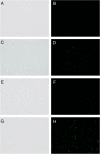A green-light inducible lytic system for cyanobacterial cells
- PMID: 24713090
- PMCID: PMC4021604
- DOI: 10.1186/1754-6834-7-56
A green-light inducible lytic system for cyanobacterial cells
Abstract
Background: Cyanobacteria are an attractive candidate for the production of biofuel because of their ability to capture carbon dioxide by photosynthesis and grow on non-arable land. However, because huge quantities of water are required for cultivation, strict water management is one of the greatest issues in algae- and cyanobacteria-based biofuel production. In this study, we aim to construct a lytic cyanobacterium that can be regulated by a physical signal (green-light illumination) for future use in the recovery of biofuel related compounds.
Results: We introduced T4 bacteriophage-derived lysis genes encoding holin and endolysin under the control of the green-light regulated cpcG2 promoter in Synechocystis sp. PCC 6803. When cells harboring the lysis genes were illuminated with both red and green light, we observed a considerable decrease in growth rate, a significant increase in cellular phycocyanin released in the medium, and a considerable fraction of dead cells. These effects were not observed when these cells were illuminated with only red light, or when cells not containing the lysis genes were grown under either red light or red and green light. These results indicate that our constructed green-light inducible lytic system was clearly induced by green-light illumination, resulting in lytic cells that released intracellular phycocyanin into the culture supernatant. This property suggests a future possibility to construct photosynthetic genetically modified organisms that are unable to survive under sunlight exposure. Expression of the self-lysis system with green-light illumination was also found to greatly increase the fragility of the cell membrane, as determined by subjecting the induced cells to detergent, osmotic-shock, and freeze-thaw treatments.
Conclusions: A green-light inducible lytic system was constructed in Synechocystis sp. PCC 6803. The engineered lytic cyanobacterial cells should be beneficial for the recovery of biofuels and related compounds from cells with minimal effort and energy, due to the fragile nature of the induced cells. Furthermore, the use of light-sensing two-component systems to regulate the expression of exogenous genes in cyanobacteria promises to replace conventional chemical inducers in many bioprocess applications, impacting the limiting water management issues.
Keywords: Cyanobacteria; Self-lysis; Synthetic biology; T4 bacteriophage; Two-component system.
Figures





Similar articles
-
Light-induced production of isobutanol and 3-methyl-1-butanol by metabolically engineered cyanobacteria.Microb Cell Fact. 2022 Jan 6;21(1):7. doi: 10.1186/s12934-021-01732-x. Microb Cell Fact. 2022. PMID: 34991586 Free PMC article.
-
Development of a light-regulated cell-recovery system for non-photosynthetic bacteria.Microb Cell Fact. 2016 Feb 15;15:31. doi: 10.1186/s12934-016-0426-6. Microb Cell Fact. 2016. PMID: 26875863 Free PMC article.
-
Nickel-inducible lysis system in Synechocystis sp. PCC 6803.Proc Natl Acad Sci U S A. 2009 Dec 22;106(51):21550-4. doi: 10.1073/pnas.0911953106. Epub 2009 Dec 7. Proc Natl Acad Sci U S A. 2009. PMID: 19995962 Free PMC article.
-
Transporters Related to Stress Responses and Their Potential Application in Synechocystis sp. PCC 6803.Adv Exp Med Biol. 2018;1080:27-53. doi: 10.1007/978-981-13-0854-3_2. Adv Exp Med Biol. 2018. PMID: 30091090 Review.
-
Development of Synechocystis sp. PCC 6803 as a phototrophic cell factory.Mar Drugs. 2013 Aug 13;11(8):2894-916. doi: 10.3390/md11082894. Mar Drugs. 2013. PMID: 23945601 Free PMC article. Review.
Cited by
-
Artificial complementary chromatic acclimation gene expression system in Escherichia coli.Microb Cell Fact. 2021 Jul 5;20(1):128. doi: 10.1186/s12934-021-01621-3. Microb Cell Fact. 2021. PMID: 34225717 Free PMC article.
-
Building a bio-based industry in the Middle East through harnessing the potential of the Red Sea biodiversity.Appl Microbiol Biotechnol. 2017 Jun;101(12):4837-4851. doi: 10.1007/s00253-017-8310-9. Epub 2017 May 20. Appl Microbiol Biotechnol. 2017. PMID: 28528426 Free PMC article. Review.
-
Optogenetic control of gene expression in the cyanobacterium Synechococcus sp. PCC 7002.Front Bioeng Biotechnol. 2025 Jan 17;12:1529022. doi: 10.3389/fbioe.2024.1529022. eCollection 2024. Front Bioeng Biotechnol. 2025. PMID: 39898276 Free PMC article.
-
Biosafety of biotechnologically important microalgae: intrinsic suicide switch implementation in cyanobacterium Synechocystis sp. PCC 6803.Biol Open. 2016 Apr 15;5(4):519-28. doi: 10.1242/bio.017129. Biol Open. 2016. PMID: 27029902 Free PMC article.
-
Transcriptional Terminators Allow Leak-Free Chromosomal Integration of Genetic Constructs in Cyanobacteria.Microorganisms. 2019 Aug 16;7(8):263. doi: 10.3390/microorganisms7080263. Microorganisms. 2019. PMID: 31426276 Free PMC article.
References
LinkOut - more resources
Full Text Sources
Other Literature Sources

